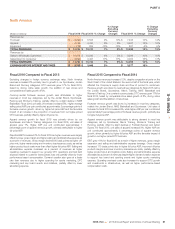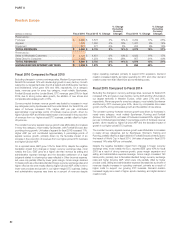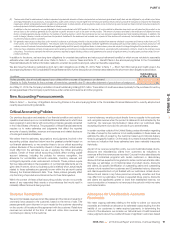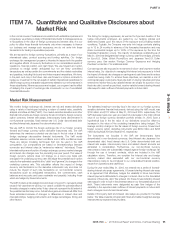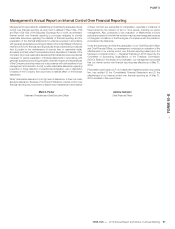Nike 2016 Annual Report Download - page 38
Download and view the complete annual report
Please find page 38 of the 2016 Nike annual report below. You can navigate through the pages in the report by either clicking on the pages listed below, or by using the keyword search tool below to find specific information within the annual report.
PART II
(2) The amounts listed for endorsement contracts represent approximate amounts of base compensation and minimum guaranteed royalty fees we are obligated to pay athlete, sport team
and league endorsers of our products. Actual payments under some contracts may be higher than the amounts listed as these contracts provide for bonuses to be paid to the endorsers
based upon athletic achievements and/or royalties on product sales in future periods. Actual payments under some contracts may also be lower as these contracts include provisions for
reduced payments if athletic performance declines in future periods.
In addition to the cash payments, we are obligated to furnish our endorsers with NIKE product for their use. It is not possible to determine how much we will spend on this product on an
annual basis as the contracts generally do not stipulate a specific amount of cash to be spent on the product. The amount of product provided to the endorsers will depend on many
factors, including general playing conditions, the number of sporting events in which they participate and our own decisions regarding product and marketing initiatives. In addition, the
costs to design, develop, source and purchase the products furnished to the endorsers are incurred over a period of time and are not necessarily tracked separately from similar costs
incurred for products sold to customers.
(3) We generally order product at least four to five months in advance of sale based primarily on futures orders received from external wholesale customers and internal orders from our DTC
in-line stores and e-commerce operations. The amounts listed for product purchase obligations represent agreements (including open purchase orders) to purchase products in the
ordinary course of business that are enforceable and legally binding and that specify all significant terms. In some cases, prices are subject to change throughout the production process.
(4) Other purchase obligations primarily include service and marketing commitments, including marketing commitments associated with endorsement contracts, made in the ordinary course
of business. The amounts represent the minimum payments required by legally binding contracts and agreements that specify all significant terms, including open purchase orders for non-
product purchases.
In addition to the above, we have long-term obligations for uncertain tax positions and various post-retirement benefits for which we are not able to reasonably
estimate when cash payments will occur. Refer to Note 9 — Income Taxes and Note 13 — Benefit Plans in the accompanying Notes to the Consolidated
Financial Statements for further information related to uncertain tax positions and post-retirement benefits, respectively.
We also have the following outstanding short-term debt obligations as of May 31, 2016. Refer to Note 7 — Short-Term Borrowings and Credit Lines in the
accompanying Notes to the Consolidated Financial Statements for further description and interest rates related to the short-term debt obligations listed below.
(In millions)
Outstanding as
of May 31, 2016
Notes payable, due at mutually agreed-upon dates within one year of issuance or on demand $ 1
Payable to Sojitz America for the purchase of inventories, generally due 60 days after shipment of goods from a foreign port 39
As of May 31, 2016, the Company had letters of credit outstanding totaling $157 million. These letters of credit were issued primarily for the purchase of inventory
and as guarantees of the Company’s performance under certain self-insurance and other programs.
New Accounting Pronouncements
Refer to Note 1 — Summary of Significant Accounting Policies in the accompanying Notes to the Consolidated Financial Statements for recently adopted and
recently issued accounting standards.
Critical Accounting Policies
Our previous discussion and analysis of our financial condition and results of
operations are based upon our consolidated financial statements, which have
been prepared in accordance with accounting principles generally accepted
in the United States of America. The preparation of these financial statements
requires us to make estimates and judgments that affect the reported
amounts of assets, liabilities, revenues and expenses and related disclosure
of contingent assets and liabilities.
We believe that the estimates, assumptions and judgments involved in the
accounting policies described below have the greatest potential impact on
our financial statements, so we consider these to be our critical accounting
policies. Because of the uncertainty inherent in these matters, actual results
could differ from the estimates we use in applying the critical accounting
policies. Certain of these critical accounting policies affect working capital
account balances, including the policies for revenue recognition, the
allowance for uncollectible accounts receivable, inventory reserves and
contingent payments under endorsement contracts. These policies require
that we make estimates in the preparation of our financial statements as of a
given date. However, since our business cycle is relatively short, actual results
related to these estimates are generally known within the six-month period
following the financial statement date. Thus, these policies generally affect
only the timing of reported amounts across two to three fiscal quarters.
Within the context of these critical accounting policies, we are not currently
aware of any reasonably likely events or circumstances that would result in
materially different amounts being reported.
Revenue Recognition
We record wholesale revenues when title passes and the risks and rewards of
ownership have passed to the customer, based on the terms of sale. Title
passes generally upon shipment or upon receipt by the customer depending
on the country of the sale and the agreement with the customer. Retail store
revenues are recorded at the time of sale and online store revenues are
recorded upon delivery to the customer.
In some instances, we ship product directly from our supplier to the customer
and recognize revenue when the product is delivered to and accepted by the
customer. Our revenues may fluctuate in cases when our customers delay
accepting shipment of product for periods of up to several weeks.
In certain countries outside of the United States, precise information regarding
the date of receipt by the customer is not readily available. In these cases, we
estimate the date of receipt by the customer based upon historical delivery
times by geographic location. On the basis of our tests of actual transactions,
we have no indication that these estimates have been materially inaccurate
historically.
As part of our revenue recognition policy, we record estimated sales returns,
discounts and miscellaneous claims from customers as reductions to
revenues at the time revenues are recorded. Our post invoice sales discounts
consist of contractual programs with certain customers or discretionary
discounts that are expected to be granted to certain customers at a later date.
We base our estimates on (1) historical rates of product returns, discounts
and claims, (2) specific identification of outstanding claims and outstanding
returns not yet received from customers and (3) estimated returns, discounts
and claims expected but not yet finalized with our customers. Actual returns,
discounts and claims in any future period are inherently uncertain and thus
may differ from our estimates. If actual or expected future returns, discounts
and claims are significantly greater or lower than established reserves, we
record a reduction or increase to net revenues in the period in which we make
such determination.
Allowance for Uncollectible Accounts
Receivable
We make ongoing estimates relating to the ability to collect our accounts
receivable and maintain an allowance for estimated losses resulting from the
inability of our customers to make required payments. In determining the
amount of the allowance, we consider our historical level of credit losses and
make judgments about the creditworthiness of significant customers based
NIKE, INC. 2016 Annual Report and Notice of Annual Meeting 91
FORM 10-K


